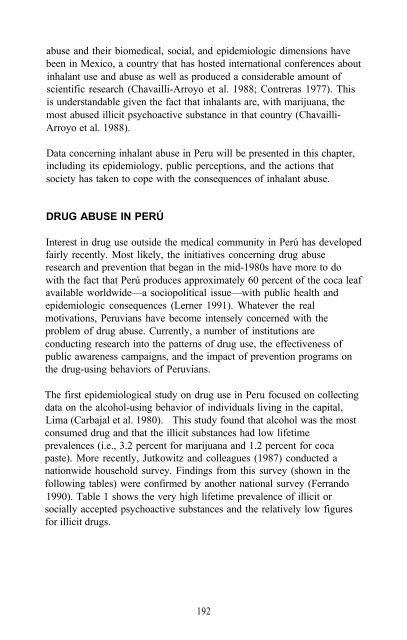Epidemiology of Inhalant Abuse - Archives - National Institute on ...
Epidemiology of Inhalant Abuse - Archives - National Institute on ...
Epidemiology of Inhalant Abuse - Archives - National Institute on ...
Create successful ePaper yourself
Turn your PDF publications into a flip-book with our unique Google optimized e-Paper software.
abuse and their biomedical, social, and epidemiologic dimensi<strong>on</strong>s have<br />
been in Mexico, a country that has hosted internati<strong>on</strong>al c<strong>on</strong>ferences about<br />
inhalant use and abuse as well as produced a c<strong>on</strong>siderable amount <str<strong>on</strong>g>of</str<strong>on</strong>g><br />
scientific research (Chavailli-Arroyo et al. 1988; C<strong>on</strong>treras 1977). This<br />
is understandable given the fact that inhalants are, with marijuana, the<br />
most abused illicit psychoactive substance in that country (Chavailli-<br />
Arroyo et al. 1988).<br />
Data c<strong>on</strong>cerning inhalant abuse in Peru will be presented in this chapter,<br />
including its epidemiology, public percepti<strong>on</strong>s, and the acti<strong>on</strong>s that<br />
society has taken to cope with the c<strong>on</strong>sequences <str<strong>on</strong>g>of</str<strong>on</strong>g> inhalant abuse.<br />
DRUG ABUSE IN PERÚ<br />
Interest in drug use outside the medical community in Perú has developed<br />
fairly recently. Most likely, the initiatives c<strong>on</strong>cerning drug abuse<br />
research and preventi<strong>on</strong> that began in the mid-1980s have more to do<br />
with the fact that Perú produces approximately 60 percent <str<strong>on</strong>g>of</str<strong>on</strong>g> the coca leaf<br />
available worldwide—a sociopolitical issue—with public health and<br />
epidemiologic c<strong>on</strong>sequences (Lerner 1991). Whatever the real<br />
motivati<strong>on</strong>s, Peruvians have become intensely c<strong>on</strong>cerned with the<br />
problem <str<strong>on</strong>g>of</str<strong>on</strong>g> drug abuse. Currently, a number <str<strong>on</strong>g>of</str<strong>on</strong>g> instituti<strong>on</strong>s are<br />
c<strong>on</strong>ducting research into the patterns <str<strong>on</strong>g>of</str<strong>on</strong>g> drug use, the effectiveness <str<strong>on</strong>g>of</str<strong>on</strong>g><br />
public awareness campaigns, and the impact <str<strong>on</strong>g>of</str<strong>on</strong>g> preventi<strong>on</strong> programs <strong>on</strong><br />
the drug-using behaviors <str<strong>on</strong>g>of</str<strong>on</strong>g> Peruvians.<br />
The first epidemiological study <strong>on</strong> drug use in Peru focused <strong>on</strong> collecting<br />
data <strong>on</strong> the alcohol-using behavior <str<strong>on</strong>g>of</str<strong>on</strong>g> individuals living in the capital,<br />
Lima (Carbajal et al. 1980). This study found that alcohol was the most<br />
c<strong>on</strong>sumed drug and that the illicit substances had low lifetime<br />
prevalences (i.e., 3.2 percent for marijuana and 1.2 percent for coca<br />
paste). More recently, Jutkowitz and colleagues (1987) c<strong>on</strong>ducted a<br />
nati<strong>on</strong>wide household survey. Findings from this survey (shown in the<br />
following tables) were c<strong>on</strong>firmed by another nati<strong>on</strong>al survey (Ferrando<br />
1990). Table 1 shows the very high lifetime prevalence <str<strong>on</strong>g>of</str<strong>on</strong>g> illicit or<br />
socially accepted psychoactive substances and the relatively low figures<br />
for illicit drugs.<br />
192
















